This post is also available in:
 עברית (Hebrew)
עברית (Hebrew)
New research may have vital applications in areas such as human-intelligence analytics. Traditionally, emotion detection has relied on the assessment of visible signals such as facial expressions, speech, body gestures or eye movements. However, these methods can be unreliable as they do not effectively capture an individual’s internal emotions. A novel artificial intelligence approach based on wireless signals could help to reveal our inner emotions.
The research from Queen Mary University of London demonstrates the use of radio waves to measure heart rate and breathing signals and predict how someone is feeling even in the absence of any other visual cues, such as facial expressions. It demonstrates how to apply a neural network to decipher emotions gathered with transmitting radio antenna.
In a testing, participants were initially asked to watch a video selected by researchers for its ability to evoke one of four basic emotion types; anger, sadness, joy and pleasure. Whilst the individual was watching the video the researchers then emitted harmless radio signals, like those transmitted from any wireless system including radar or WiFi, towards the individual and measured the signals that bounced back off them. By analysing changes to these signals caused by slight body movements, the researchers were able to reveal ‘hidden’ information about an individual’s heart and breathing rates.
While previous research data analysis has depended on the use of classical machine learning approaches, the scientists instead employed deep learning techniques, where an artificial neural network learns its own features from time-dependent raw data, and showed that this approach could detect emotions more accurately than traditional machine learning methods, according to eurekalert.org.
ECG signals detect electrical activity in the heart, providing a link between the nervous system and heart rhythm. To date the measurement of these signals has largely been performed using sensors that are placed on the body, but recently researchers have been looking towards non-invasive approaches that use radio waves, to detect these signals.In the future, the research team plans to work with healthcare professionals and social scientists on public acceptance and ethical concerns around the use of this technology.
Ahsan Noor Khan, a PhD student at Queen Mary and first author of the study, said: “Being able to detect emotions using wireless systems is a topic of increasing interest for researchers as it offers an alternative to bulky sensors and could be directly applicable in future ‘smart’ home and building environments. In this study, we’ve built on existing work using radio waves to detect emotions and show that the use of deep learning techniques can improve the accuracy of our results.”
“We’re now looking to investigate how we could use low-cost existing systems, such as WiFi routers, to detect emotions of a large number of people gathered, for instance in an office or work environment. This type of approach would enable us to classify emotions of people on an individual basis while performing routine activities.”
Prepared to dive into the world of futuristic technology? Attend INNOTECH 2023, the international convention and exhibition for cyber, HLS and innovation at Expo, Tel Aviv, on March 29th-30th
Interested in sponsoring / a display booth at the 2023 INNOTECH exhibition? Click here for details!


























